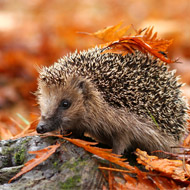Hedgehog charity issues bonfire night reminder

Always check bonfires for hedgehogs and other wildlife before lighting.
The British Hedgehog Preservation Society (BHPS) has issued a reminder to the public not to build bonfires until the day they are due to be lit.
The charity says that checking bonfires will not only save wildlife from burning to death but will also stop them getting soaked should it rain the night before.
“If material is stored on open ground in advance of having a bonfire, it’s crucial to dismantle it and move it to another spot just before lighting,” said Fay Vass, chief executive of the BHPS.
“Ensure it’s moved to clear ground - never on top of a pile of leaves as there could be a hedgehog underneath, and not too close to pampas grass which can ignite very easily and is another favourite spot for hedgehogs to hide under.”
The BHPS adds that if a bonfire has to be built in advance, it should be protected around the bottom with chicken wire. This should be at least one meter high, sloped at an angle, and held in place with stakes.
Before lighting, check for hedgehogs and other wildlife by using broom handles to lift from the base of the pile.
“If hedgehogs are found, take as much of the nest as you can and place them in a high-sided cardboard box with plenty of newspaper/old towelling,” Fay said. "Ensure there are air holes in the lid and that the lid is secured firmly to the box, as hedgehogs are great climbers.
“Put the box in a safe place such as a shed or garage well away from the festivities and offer the hedgehog some meaty cat or dog food and water.
“In case you have missed anything light the fire from one side only. Once the embers are totally dampened down, release the hedgehog under a hedge, bush or behind a stack of logs with its original nesting materials.”



 The RCVS has announced a new version of its 1CPD mobile app, with enhanced features for veterinary surgeons and veterinary nurses to record their continuing professional development.
The RCVS has announced a new version of its 1CPD mobile app, with enhanced features for veterinary surgeons and veterinary nurses to record their continuing professional development.